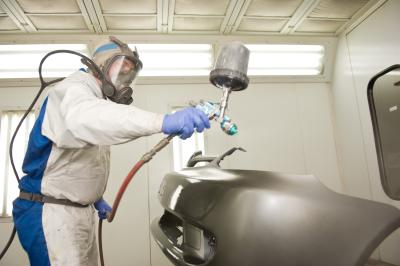
In a perfect world, a car paint job results from just the right texture, coat thickness, proper atomizing, solvent mix and temperature. Professional automotive painting takes a long time to learn, since many factors affect the overall outcome. Orange peel is a common painting flaw, and it shows up in the paint surface as a pebbled or small clumpy formation resembling the surface texture of an orange's skin. Several factors cause orange peel, and every painter, especially the novice, should be aware of what causes it and how to prevent it.
The ideal temperature for auto painting is around 72.5 degrees F. A broader, acceptable range would be from approximately 65 to 82. Paint will not stay fluid long enough when sprayed from a gun at temperatures approaching 90 and more. This higher temperature can cause orange peel, since the paint droplets are drying prematurely before they contact the surface. Temperatures below 50 will also cause inconsistency in paint layer quality. Humidity reaching 50 percent or more will alter drying time and produce defects in the paint's appearance. Paint should not be applied in direct sunlight or in windy or rainy conditions.
A spray gun should be held at a right angle to the surface, and roughly 6 to 10 inches away. The distance can vary slightly, depending upon the type of paint used and the temperature. Guns held too far away will cause orange peel, since the paint will not reach the surface in a fluid condition. Most important is to hold the gun at a distance that produces a fine, even mist with one pass from end to end over the surface. The gun should not be held at an angle, which results in an uneven spray pattern. Fanning the gun can produce orange peel. Adjust the nozzle for the correct width of the spray pattern. Overly wide spray patterns will not allow enough paint concentration for a thick enough coating, allowing premature drying of the paint droplets.
The spray tip, or nozzle size of the gun, should correspond to the type of paint used. Nozzles control the size of the mist droplets that exit the gun. Primers, base coats and clear coats, as well as some candy and pearl types of paint, might require a nozzle change. Nozzles can range from 1.2 mm to 2.2 mm. A good nozzle size for automotive painting is 1.3 to 1.4. The paint manufacturer will recommend the proper nozzle size for their specific paint type.
Spray guns and compressors have ratings. The gun should be matched to the compressor. For adequate pressure, a compressor should produce at least 1 1/2 times the cubic feet per minute rating of the gun. For instance, if a gun has an 8.6 cfm rating at 40 psi, it will need a compressor that delivers at least 12.9 cfm at a constant rate. Low pressure can cause orange peel since the paint does not mist or atomize correctly before surface contact. Small compressors with limited capacity and power will also not produce a sufficient, constant or evenly fine spray pattern.
The reducer or thinner used to thin the paint must correspond to the correct ratio needed. Paint thickness is called viscosity. Product directions must be followed to mix the correct ratio of reducer. Spray gun manufacturers will recommend certain viscosity. You can measure paint thickness with a viscosity cup, such as the Zahn cup, by dipping the cup into the paint and recording the number of seconds it takes for the paint to drain. Refer to a viscosity chart that indicates the proper viscosity and conversions for your application. The temperature must be consistent between measuring and application. A lack of reducer-thinner, or a high-evaporating thinner, will cause premature drying of the paint droplets, causing orange peel.
If the surface of the body panel has not been properly sanded to a smooth, even finish, an orange peel affect can appear, even thought the paint mixture, pressure, temperature, technique and nozzle size is correct. Proper sanding with very fine, wet sandpaper will eliminate the appearance of orange peel before paint application.
Incorrect drying time between coats can produce orange peel, especially overdrying. For example, if a first enamel coat is allowed to dry and set up, the thinner solvents in the next coat will seep into the first coat. Orange peel results, since the paint molecules cannot disperse and flow together evenly. Drying times for colder weather or higher humidity should be extended.